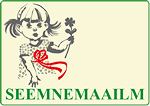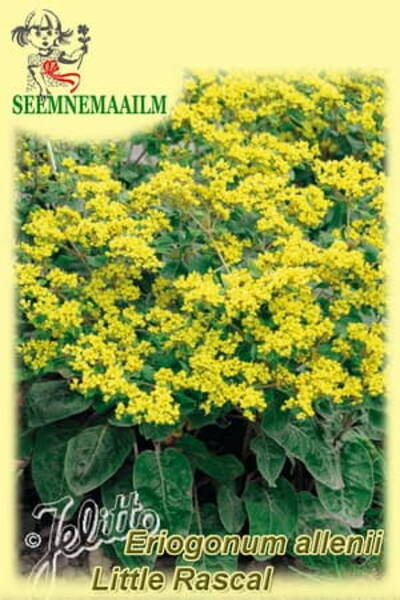Your shopping cart is empty!
Shale Barrens Buckwheat "Little Rascal"
Shale Barrens Buckwheat "Little Rascal" - Eriogonum allenii.
Family: Polygonaceae.
Origin: Virginia and West Virginia (USA).
Special Features: Astoundingly beautiful, rare, long flowering, drought-tolerant, durable species.
History: Introduced by JELITTO PERENNIAL SEEDS in 2009.
The name Eriogonum originated from the Greek erion, wool, and, gony, knee on account of the hairy stems of many of the species.
Colour: Golden parasols.
Natural Flowering Period: June - September.
Winter Hardiness Zones: Z5-10.
Growth Habit.
Upright Foliage: Handsome, grey-green paddle-shaped leaves form tight rosettes.
Height with Flowers: 40 cm.
Spacing between Plants: 40 cm.
Soil Requirements: Well-drained soils, pH 5.5 - 6.5.
Location: Full sun.
Use: Plant in the rock garden, dry areas or mixed containers with Scabiosa, Seseli gummiferum and Penstemon.
Specialities: Great plant for bees and cut flowers.
Cultural Tips.
Grams per 1000 Seeds: 1,724.
Seeds per Gram: 580.
Seeding Recommendation: 5 g / 1000 plants.
Sowing Rate: 2-3 seeds per cell.
Plug tray recommended size(s): Open flats or 72s.
Germination: These seeds germinate rapidly depending on species and origin. If germination does not occur after 3-4 weeks a cooling period of 2-4 weeks is recommended. Scheduling.
Best Sowing Dates: November - March.
Sowing to Germination: 8 - 12 weeks.
Germination to Transplant: 4 - 6 weeks.
Transplanting to Salable Plant: 6 - 8 weeks.
Cutting-Back at Transplanting: Not necessary.
* Eriogonums need deep root penetration wherever they are grown. They grow best in hot, dry gardens and sometimes succeed in raised or normal positions in rock gardens. In coarse sand based mixes the top layer of the mix should be 30 cm or a layer of 15 cm of pure coarse sand is possible. Coarse sand is the main requirement for the survival of plants in damp cold winters. In a trial of two plants grown in ordinary garden soil with fine sand, the plants grew relatively well in spring and early summer, but died during hot weather, as the roots could not penetrate deep into the soil to the damp layers. Sufficient coarse sand helps the roots to penetrate deep and also ensures the rapid drainage of excess moisture. In the UK, plants are widely grown in containers (more than anywhere else in the world), and this is the most suitable way to grow Eriogonums. Soil mixtures used for eriogonums should contain at least 50% coarse sand, and if grown in containers, the moisture level should be checked almost daily throughout the summer. Overwintering plants in alpine greenhouses allows plants to start growing much earlier than those overwintered outdoors (they will also flower earlier, of course). This genus loves the sun, and containers can be outside from late spring until autumn. Keep in mind that when using containers, the roots can overheat, so keep the containers submerged in damp sand.
Family: Polygonaceae.
Origin: Virginia and West Virginia (USA).
Special Features: Astoundingly beautiful, rare, long flowering, drought-tolerant, durable species.
History: Introduced by JELITTO PERENNIAL SEEDS in 2009.
The name Eriogonum originated from the Greek erion, wool, and, gony, knee on account of the hairy stems of many of the species.
Colour: Golden parasols.
Natural Flowering Period: June - September.
Winter Hardiness Zones: Z5-10.
Growth Habit.
Upright Foliage: Handsome, grey-green paddle-shaped leaves form tight rosettes.
Height with Flowers: 40 cm.
Spacing between Plants: 40 cm.
Soil Requirements: Well-drained soils, pH 5.5 - 6.5.
Location: Full sun.
Use: Plant in the rock garden, dry areas or mixed containers with Scabiosa, Seseli gummiferum and Penstemon.
Specialities: Great plant for bees and cut flowers.
Cultural Tips.
Grams per 1000 Seeds: 1,724.
Seeds per Gram: 580.
Seeding Recommendation: 5 g / 1000 plants.
Sowing Rate: 2-3 seeds per cell.
Plug tray recommended size(s): Open flats or 72s.
Germination: These seeds germinate rapidly depending on species and origin. If germination does not occur after 3-4 weeks a cooling period of 2-4 weeks is recommended. Scheduling.
Best Sowing Dates: November - March.
Sowing to Germination: 8 - 12 weeks.
Germination to Transplant: 4 - 6 weeks.
Transplanting to Salable Plant: 6 - 8 weeks.
Cutting-Back at Transplanting: Not necessary.
* Eriogonums need deep root penetration wherever they are grown. They grow best in hot, dry gardens and sometimes succeed in raised or normal positions in rock gardens. In coarse sand based mixes the top layer of the mix should be 30 cm or a layer of 15 cm of pure coarse sand is possible. Coarse sand is the main requirement for the survival of plants in damp cold winters. In a trial of two plants grown in ordinary garden soil with fine sand, the plants grew relatively well in spring and early summer, but died during hot weather, as the roots could not penetrate deep into the soil to the damp layers. Sufficient coarse sand helps the roots to penetrate deep and also ensures the rapid drainage of excess moisture. In the UK, plants are widely grown in containers (more than anywhere else in the world), and this is the most suitable way to grow Eriogonums. Soil mixtures used for eriogonums should contain at least 50% coarse sand, and if grown in containers, the moisture level should be checked almost daily throughout the summer. Overwintering plants in alpine greenhouses allows plants to start growing much earlier than those overwintered outdoors (they will also flower earlier, of course). This genus loves the sun, and containers can be outside from late spring until autumn. Keep in mind that when using containers, the roots can overheat, so keep the containers submerged in damp sand.












